Oracle and Sun Microsystems: Financial Analysis and Acquisition
VerifiedAdded on 2023/06/09
|11
|2264
|207
Report
AI Summary
This report provides a financial analysis of Oracle's potential acquisition of Sun Microsystems, evaluating whether the merger is a sound strategic decision and determining an optimal price for Oracle to offer. It uses a Discounted Cash Flow (DCF) valuation model, terminal value calculations, and futur...
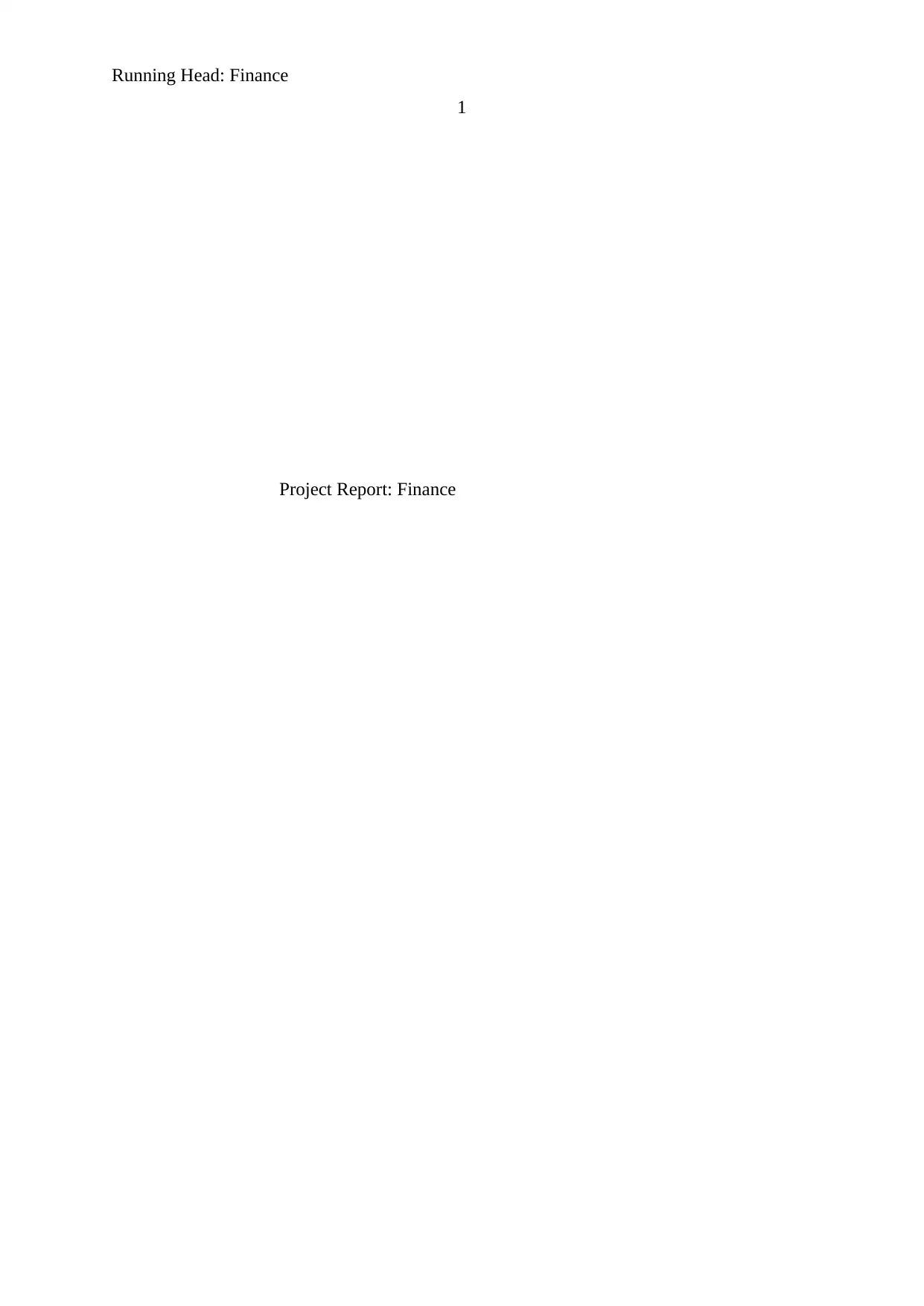
Running Head: Finance
1
Project Report: Finance
1
Project Report: Finance
Paraphrase This Document
Need a fresh take? Get an instant paraphrase of this document with our AI Paraphraser

Finance
2
Contents
Introduction.......................................................................................................................3
Good fit for oracle............................................................................................................3
Approaches.......................................................................................................................3
DCF valuation...................................................................................................................3
Multiple analyses..............................................................................................................4
Synergies and sensitivity analysis....................................................................................4
Price..................................................................................................................................5
Conclusion........................................................................................................................5
References.........................................................................................................................6
Appendix...........................................................................................................................7
2
Contents
Introduction.......................................................................................................................3
Good fit for oracle............................................................................................................3
Approaches.......................................................................................................................3
DCF valuation...................................................................................................................3
Multiple analyses..............................................................................................................4
Synergies and sensitivity analysis....................................................................................4
Price..................................................................................................................................5
Conclusion........................................................................................................................5
References.........................................................................................................................6
Appendix...........................................................................................................................7
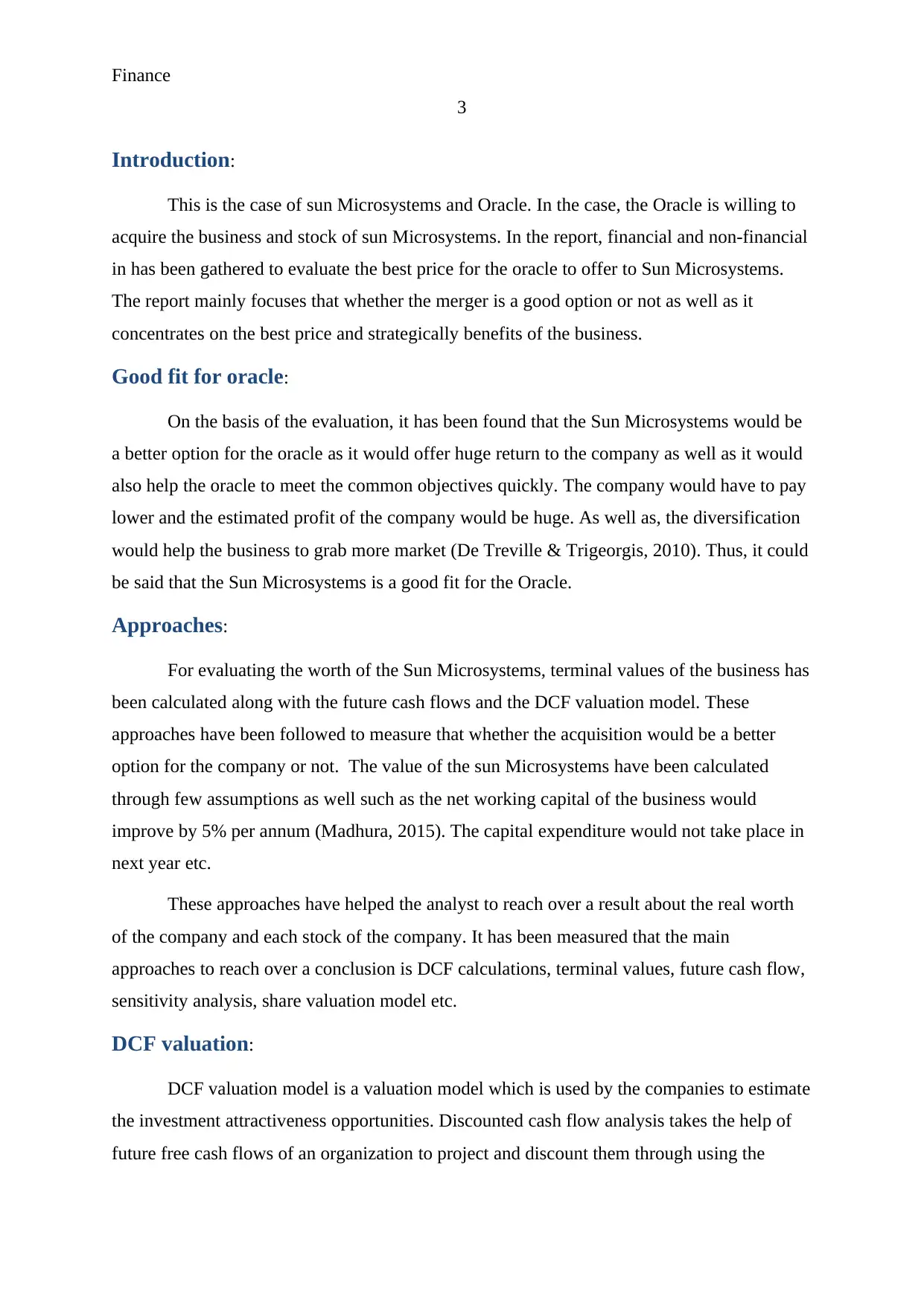
Finance
3
Introduction:
This is the case of sun Microsystems and Oracle. In the case, the Oracle is willing to
acquire the business and stock of sun Microsystems. In the report, financial and non-financial
in has been gathered to evaluate the best price for the oracle to offer to Sun Microsystems.
The report mainly focuses that whether the merger is a good option or not as well as it
concentrates on the best price and strategically benefits of the business.
Good fit for oracle:
On the basis of the evaluation, it has been found that the Sun Microsystems would be
a better option for the oracle as it would offer huge return to the company as well as it would
also help the oracle to meet the common objectives quickly. The company would have to pay
lower and the estimated profit of the company would be huge. As well as, the diversification
would help the business to grab more market (De Treville & Trigeorgis, 2010). Thus, it could
be said that the Sun Microsystems is a good fit for the Oracle.
Approaches:
For evaluating the worth of the Sun Microsystems, terminal values of the business has
been calculated along with the future cash flows and the DCF valuation model. These
approaches have been followed to measure that whether the acquisition would be a better
option for the company or not. The value of the sun Microsystems have been calculated
through few assumptions as well such as the net working capital of the business would
improve by 5% per annum (Madhura, 2015). The capital expenditure would not take place in
next year etc.
These approaches have helped the analyst to reach over a result about the real worth
of the company and each stock of the company. It has been measured that the main
approaches to reach over a conclusion is DCF calculations, terminal values, future cash flow,
sensitivity analysis, share valuation model etc.
DCF valuation:
DCF valuation model is a valuation model which is used by the companies to estimate
the investment attractiveness opportunities. Discounted cash flow analysis takes the help of
future free cash flows of an organization to project and discount them through using the
3
Introduction:
This is the case of sun Microsystems and Oracle. In the case, the Oracle is willing to
acquire the business and stock of sun Microsystems. In the report, financial and non-financial
in has been gathered to evaluate the best price for the oracle to offer to Sun Microsystems.
The report mainly focuses that whether the merger is a good option or not as well as it
concentrates on the best price and strategically benefits of the business.
Good fit for oracle:
On the basis of the evaluation, it has been found that the Sun Microsystems would be
a better option for the oracle as it would offer huge return to the company as well as it would
also help the oracle to meet the common objectives quickly. The company would have to pay
lower and the estimated profit of the company would be huge. As well as, the diversification
would help the business to grab more market (De Treville & Trigeorgis, 2010). Thus, it could
be said that the Sun Microsystems is a good fit for the Oracle.
Approaches:
For evaluating the worth of the Sun Microsystems, terminal values of the business has
been calculated along with the future cash flows and the DCF valuation model. These
approaches have been followed to measure that whether the acquisition would be a better
option for the company or not. The value of the sun Microsystems have been calculated
through few assumptions as well such as the net working capital of the business would
improve by 5% per annum (Madhura, 2015). The capital expenditure would not take place in
next year etc.
These approaches have helped the analyst to reach over a result about the real worth
of the company and each stock of the company. It has been measured that the main
approaches to reach over a conclusion is DCF calculations, terminal values, future cash flow,
sensitivity analysis, share valuation model etc.
DCF valuation:
DCF valuation model is a valuation model which is used by the companies to estimate
the investment attractiveness opportunities. Discounted cash flow analysis takes the help of
future free cash flows of an organization to project and discount them through using the
⊘ This is a preview!⊘
Do you want full access?
Subscribe today to unlock all pages.

Trusted by 1+ million students worldwide

Finance
4
required annual rate of the business to reach over the present value estimates of the business
(Higgins, 2012). In this case, the DCF valuation model has been applied and the following
result has been got:
a. The required rate of return on acquisition of sun Microsystems have been calculated
and it has been found that the discrete cash flow growth of the business is 7.85%
however, if we talk about the permanent growth rate of the country than it is 3.76%.
So, it could be said that the required rate of return would be higher than the permanent
growth rate of the economy.
b. The base cash flow of the business has been forecasted through measuring the last
year cash flows and the future prediction on the cash flows of the business. The case
and the calculations explain that the base cash flow of the business is $ 739.35.
c. Further, the terminal value represents the future cash flows of the business in the asset
valuation model. It is the present value of future cash flows of a business. Through the
calculations, it has been measured that the terminal cash flows of the business of
future 10 years would be $ 78,203.70 (Bai, Wang & Sapiro, 2010).
d. Equity value explains the total market value of the stock of the business in current
scenario. It evaluates the overall performance of the business and explains that the
stock price of the business should be this rather than the current value. On the basis of
the calculations, it has been measured that per share value of the Sun Microsystems’s
share must be $ 19.70 which is quite higher than the current stock price and it
explains that the stocks of the company are undervalued.
Multiple analyses:
The DCF valuation model has been applied on the business to measure that whether
the stock price offered by the Oracle limited is better or not. The DCF valuation model has
been applied on the sun Microsystems and it has been measured that per share value of the
Sun Microsystems’s share must be $ 19.70 which is quite higher than the current stock price
and it explains that the stocks of the company are undervalued (Chandra, 2011). The stock
price offered by Oracle is $ 9.5 (which is even on premium) is quite lower than the actual
stock price of the business. It explains that the offered price is quite beneficial for the Oracle
limited.
4
required annual rate of the business to reach over the present value estimates of the business
(Higgins, 2012). In this case, the DCF valuation model has been applied and the following
result has been got:
a. The required rate of return on acquisition of sun Microsystems have been calculated
and it has been found that the discrete cash flow growth of the business is 7.85%
however, if we talk about the permanent growth rate of the country than it is 3.76%.
So, it could be said that the required rate of return would be higher than the permanent
growth rate of the economy.
b. The base cash flow of the business has been forecasted through measuring the last
year cash flows and the future prediction on the cash flows of the business. The case
and the calculations explain that the base cash flow of the business is $ 739.35.
c. Further, the terminal value represents the future cash flows of the business in the asset
valuation model. It is the present value of future cash flows of a business. Through the
calculations, it has been measured that the terminal cash flows of the business of
future 10 years would be $ 78,203.70 (Bai, Wang & Sapiro, 2010).
d. Equity value explains the total market value of the stock of the business in current
scenario. It evaluates the overall performance of the business and explains that the
stock price of the business should be this rather than the current value. On the basis of
the calculations, it has been measured that per share value of the Sun Microsystems’s
share must be $ 19.70 which is quite higher than the current stock price and it
explains that the stocks of the company are undervalued.
Multiple analyses:
The DCF valuation model has been applied on the business to measure that whether
the stock price offered by the Oracle limited is better or not. The DCF valuation model has
been applied on the sun Microsystems and it has been measured that per share value of the
Sun Microsystems’s share must be $ 19.70 which is quite higher than the current stock price
and it explains that the stocks of the company are undervalued (Chandra, 2011). The stock
price offered by Oracle is $ 9.5 (which is even on premium) is quite lower than the actual
stock price of the business. It explains that the offered price is quite beneficial for the Oracle
limited.
Paraphrase This Document
Need a fresh take? Get an instant paraphrase of this document with our AI Paraphraser
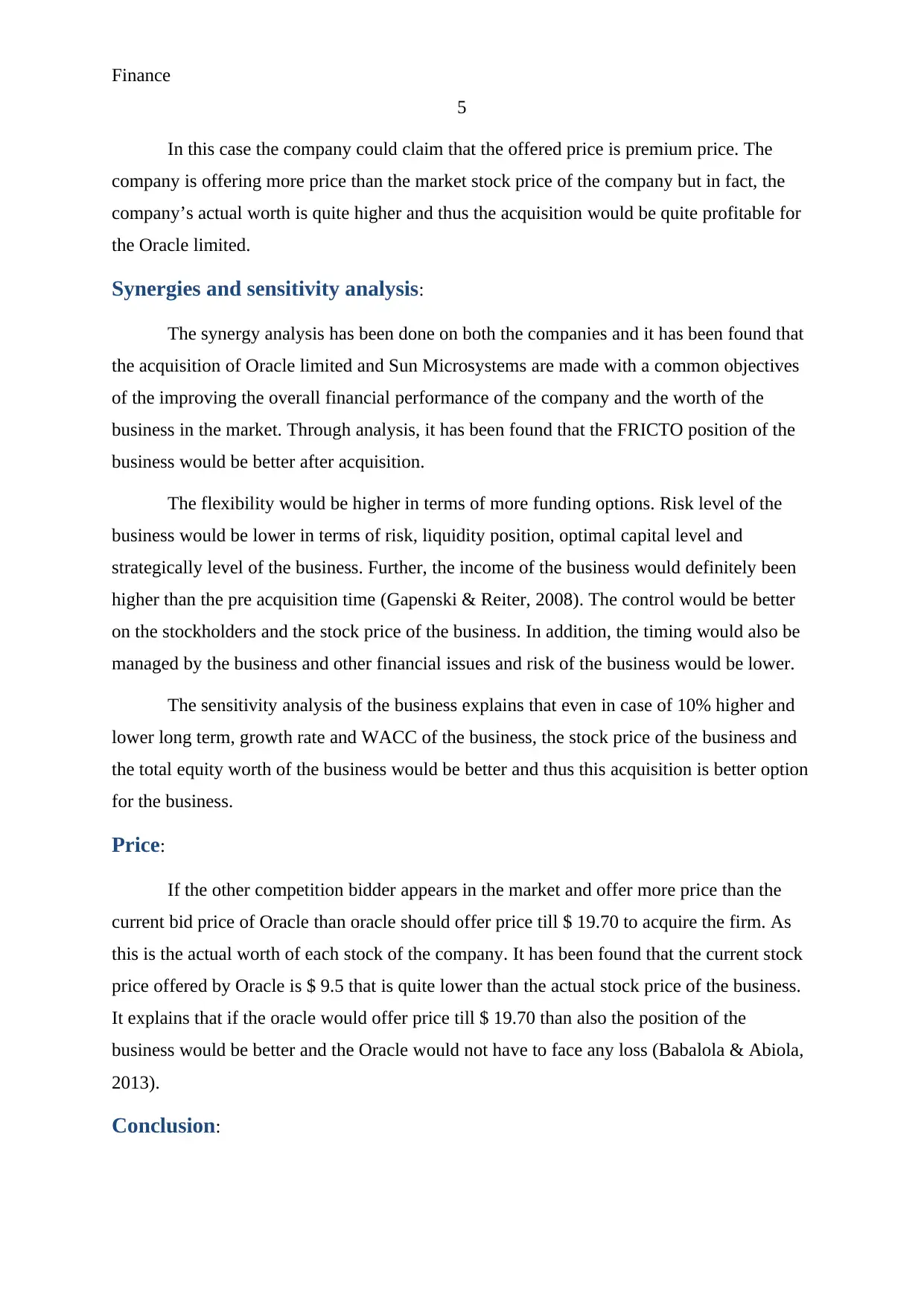
Finance
5
In this case the company could claim that the offered price is premium price. The
company is offering more price than the market stock price of the company but in fact, the
company’s actual worth is quite higher and thus the acquisition would be quite profitable for
the Oracle limited.
Synergies and sensitivity analysis:
The synergy analysis has been done on both the companies and it has been found that
the acquisition of Oracle limited and Sun Microsystems are made with a common objectives
of the improving the overall financial performance of the company and the worth of the
business in the market. Through analysis, it has been found that the FRICTO position of the
business would be better after acquisition.
The flexibility would be higher in terms of more funding options. Risk level of the
business would be lower in terms of risk, liquidity position, optimal capital level and
strategically level of the business. Further, the income of the business would definitely been
higher than the pre acquisition time (Gapenski & Reiter, 2008). The control would be better
on the stockholders and the stock price of the business. In addition, the timing would also be
managed by the business and other financial issues and risk of the business would be lower.
The sensitivity analysis of the business explains that even in case of 10% higher and
lower long term, growth rate and WACC of the business, the stock price of the business and
the total equity worth of the business would be better and thus this acquisition is better option
for the business.
Price:
If the other competition bidder appears in the market and offer more price than the
current bid price of Oracle than oracle should offer price till $ 19.70 to acquire the firm. As
this is the actual worth of each stock of the company. It has been found that the current stock
price offered by Oracle is $ 9.5 that is quite lower than the actual stock price of the business.
It explains that if the oracle would offer price till $ 19.70 than also the position of the
business would be better and the Oracle would not have to face any loss (Babalola & Abiola,
2013).
Conclusion:
5
In this case the company could claim that the offered price is premium price. The
company is offering more price than the market stock price of the company but in fact, the
company’s actual worth is quite higher and thus the acquisition would be quite profitable for
the Oracle limited.
Synergies and sensitivity analysis:
The synergy analysis has been done on both the companies and it has been found that
the acquisition of Oracle limited and Sun Microsystems are made with a common objectives
of the improving the overall financial performance of the company and the worth of the
business in the market. Through analysis, it has been found that the FRICTO position of the
business would be better after acquisition.
The flexibility would be higher in terms of more funding options. Risk level of the
business would be lower in terms of risk, liquidity position, optimal capital level and
strategically level of the business. Further, the income of the business would definitely been
higher than the pre acquisition time (Gapenski & Reiter, 2008). The control would be better
on the stockholders and the stock price of the business. In addition, the timing would also be
managed by the business and other financial issues and risk of the business would be lower.
The sensitivity analysis of the business explains that even in case of 10% higher and
lower long term, growth rate and WACC of the business, the stock price of the business and
the total equity worth of the business would be better and thus this acquisition is better option
for the business.
Price:
If the other competition bidder appears in the market and offer more price than the
current bid price of Oracle than oracle should offer price till $ 19.70 to acquire the firm. As
this is the actual worth of each stock of the company. It has been found that the current stock
price offered by Oracle is $ 9.5 that is quite lower than the actual stock price of the business.
It explains that if the oracle would offer price till $ 19.70 than also the position of the
business would be better and the Oracle would not have to face any loss (Babalola & Abiola,
2013).
Conclusion:

Finance
6
To conclude, the acquisition of Oracle limited and Sun Microsystems are made with a
common objectives of the improving the overall financial performance of the company and
the worth of the business in the market. It has been found that the current stock price offered
by Oracle is $ 9.5 that is quite lower than the actual stock price of the business that is $ 19.7.
It explains that in this case, the profitability position and the financial worth of the business
would be higher.
6
To conclude, the acquisition of Oracle limited and Sun Microsystems are made with a
common objectives of the improving the overall financial performance of the company and
the worth of the business in the market. It has been found that the current stock price offered
by Oracle is $ 9.5 that is quite lower than the actual stock price of the business that is $ 19.7.
It explains that in this case, the profitability position and the financial worth of the business
would be higher.
⊘ This is a preview!⊘
Do you want full access?
Subscribe today to unlock all pages.

Trusted by 1+ million students worldwide
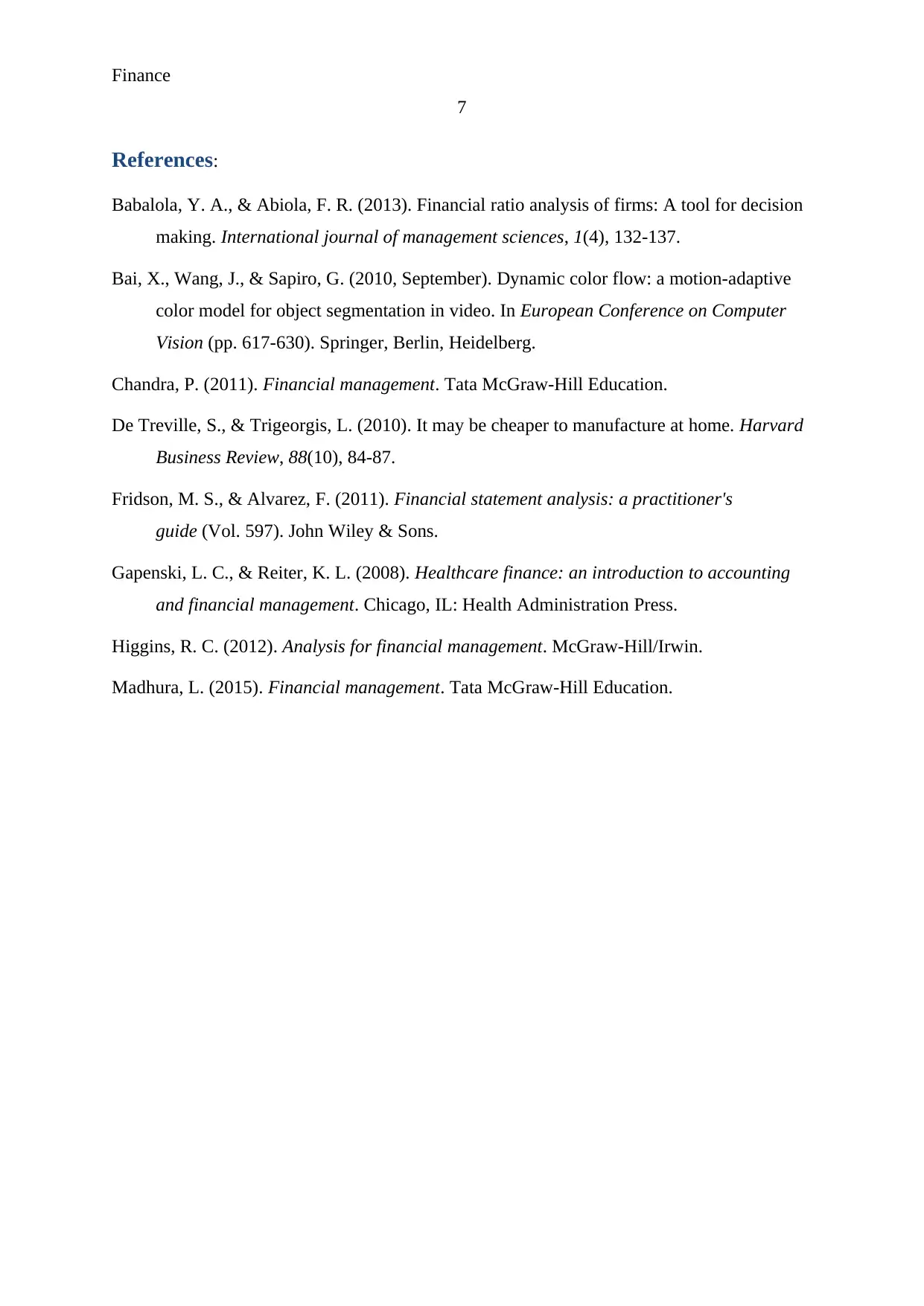
Finance
7
References:
Babalola, Y. A., & Abiola, F. R. (2013). Financial ratio analysis of firms: A tool for decision
making. International journal of management sciences, 1(4), 132-137.
Bai, X., Wang, J., & Sapiro, G. (2010, September). Dynamic color flow: a motion-adaptive
color model for object segmentation in video. In European Conference on Computer
Vision (pp. 617-630). Springer, Berlin, Heidelberg.
Chandra, P. (2011). Financial management. Tata McGraw-Hill Education.
De Treville, S., & Trigeorgis, L. (2010). It may be cheaper to manufacture at home. Harvard
Business Review, 88(10), 84-87.
Fridson, M. S., & Alvarez, F. (2011). Financial statement analysis: a practitioner's
guide (Vol. 597). John Wiley & Sons.
Gapenski, L. C., & Reiter, K. L. (2008). Healthcare finance: an introduction to accounting
and financial management. Chicago, IL: Health Administration Press.
Higgins, R. C. (2012). Analysis for financial management. McGraw-Hill/Irwin.
Madhura, L. (2015). Financial management. Tata McGraw-Hill Education.
7
References:
Babalola, Y. A., & Abiola, F. R. (2013). Financial ratio analysis of firms: A tool for decision
making. International journal of management sciences, 1(4), 132-137.
Bai, X., Wang, J., & Sapiro, G. (2010, September). Dynamic color flow: a motion-adaptive
color model for object segmentation in video. In European Conference on Computer
Vision (pp. 617-630). Springer, Berlin, Heidelberg.
Chandra, P. (2011). Financial management. Tata McGraw-Hill Education.
De Treville, S., & Trigeorgis, L. (2010). It may be cheaper to manufacture at home. Harvard
Business Review, 88(10), 84-87.
Fridson, M. S., & Alvarez, F. (2011). Financial statement analysis: a practitioner's
guide (Vol. 597). John Wiley & Sons.
Gapenski, L. C., & Reiter, K. L. (2008). Healthcare finance: an introduction to accounting
and financial management. Chicago, IL: Health Administration Press.
Higgins, R. C. (2012). Analysis for financial management. McGraw-Hill/Irwin.
Madhura, L. (2015). Financial management. Tata McGraw-Hill Education.
Paraphrase This Document
Need a fresh take? Get an instant paraphrase of this document with our AI Paraphraser
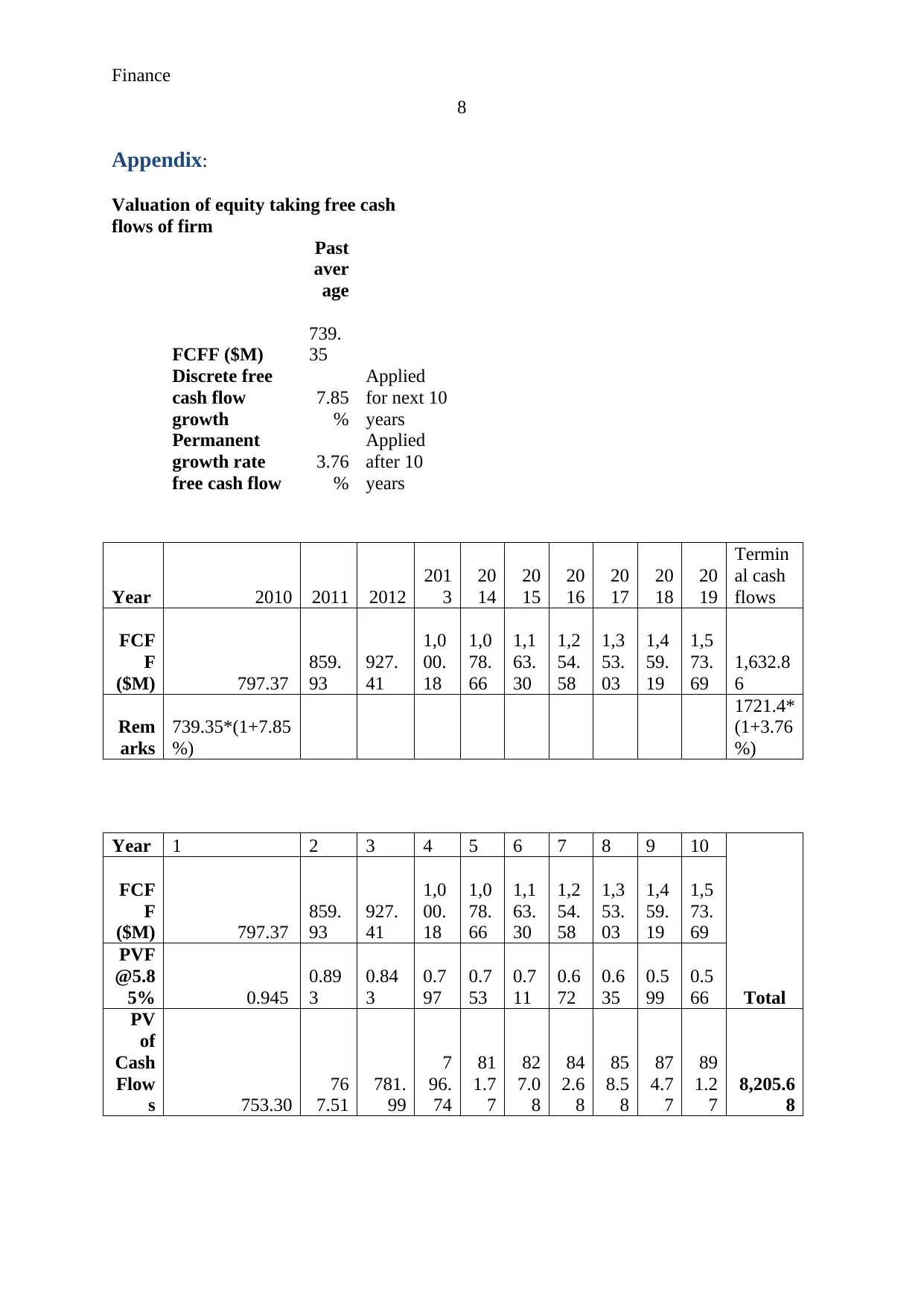
Finance
8
Appendix:
Valuation of equity taking free cash
flows of firm
Past
aver
age
FCFF ($M)
739.
35
Discrete free
cash flow
growth
7.85
%
Applied
for next 10
years
Permanent
growth rate
free cash flow
3.76
%
Applied
after 10
years
Year 2010 2011 2012
201
3
20
14
20
15
20
16
20
17
20
18
20
19
Termin
al cash
flows
FCF
F
($M) 797.37
859.
93
927.
41
1,0
00.
18
1,0
78.
66
1,1
63.
30
1,2
54.
58
1,3
53.
03
1,4
59.
19
1,5
73.
69
1,632.8
6
Rem
arks
739.35*(1+7.85
%)
1721.4*
(1+3.76
%)
Year 1 2 3 4 5 6 7 8 9 10
Total
FCF
F
($M) 797.37
859.
93
927.
41
1,0
00.
18
1,0
78.
66
1,1
63.
30
1,2
54.
58
1,3
53.
03
1,4
59.
19
1,5
73.
69
PVF
@5.8
5% 0.945
0.89
3
0.84
3
0.7
97
0.7
53
0.7
11
0.6
72
0.6
35
0.5
99
0.5
66
PV
of
Cash
Flow
s 753.30
76
7.51
781.
99
7
96.
74
81
1.7
7
82
7.0
8
84
2.6
8
85
8.5
8
87
4.7
7
89
1.2
7
8,205.6
8
8
Appendix:
Valuation of equity taking free cash
flows of firm
Past
aver
age
FCFF ($M)
739.
35
Discrete free
cash flow
growth
7.85
%
Applied
for next 10
years
Permanent
growth rate
free cash flow
3.76
%
Applied
after 10
years
Year 2010 2011 2012
201
3
20
14
20
15
20
16
20
17
20
18
20
19
Termin
al cash
flows
FCF
F
($M) 797.37
859.
93
927.
41
1,0
00.
18
1,0
78.
66
1,1
63.
30
1,2
54.
58
1,3
53.
03
1,4
59.
19
1,5
73.
69
1,632.8
6
Rem
arks
739.35*(1+7.85
%)
1721.4*
(1+3.76
%)
Year 1 2 3 4 5 6 7 8 9 10
Total
FCF
F
($M) 797.37
859.
93
927.
41
1,0
00.
18
1,0
78.
66
1,1
63.
30
1,2
54.
58
1,3
53.
03
1,4
59.
19
1,5
73.
69
PVF
@5.8
5% 0.945
0.89
3
0.84
3
0.7
97
0.7
53
0.7
11
0.6
72
0.6
35
0.5
99
0.5
66
PV
of
Cash
Flow
s 753.30
76
7.51
781.
99
7
96.
74
81
1.7
7
82
7.0
8
84
2.6
8
85
8.5
8
87
4.7
7
89
1.2
7
8,205.6
8
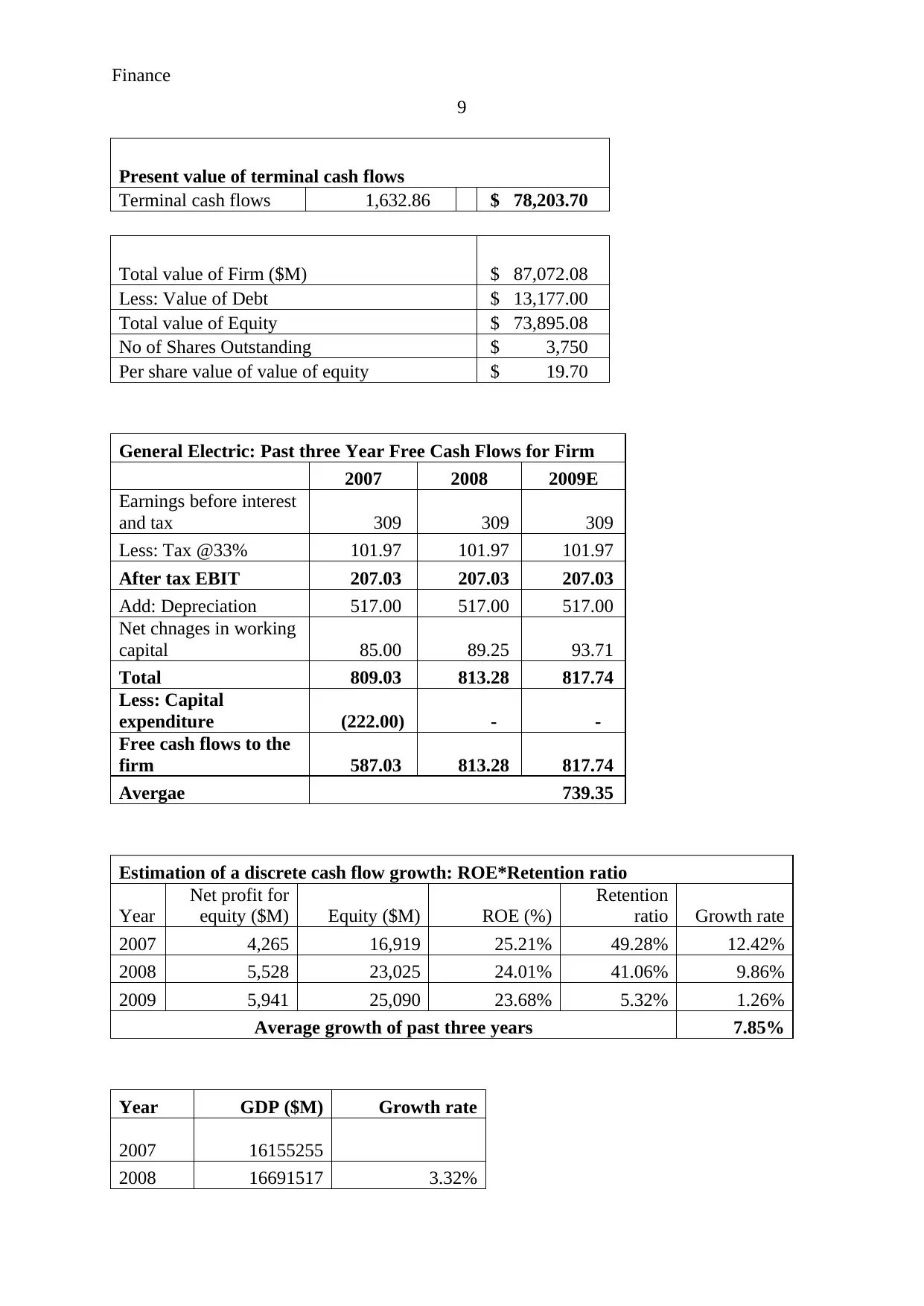
Finance
9
Present value of terminal cash flows
Terminal cash flows 1,632.86 $ 78,203.70
Total value of Firm ($M) $ 87,072.08
Less: Value of Debt $ 13,177.00
Total value of Equity $ 73,895.08
No of Shares Outstanding $ 3,750
Per share value of value of equity $ 19.70
General Electric: Past three Year Free Cash Flows for Firm
2007 2008 2009E
Earnings before interest
and tax 309 309 309
Less: Tax @33% 101.97 101.97 101.97
After tax EBIT 207.03 207.03 207.03
Add: Depreciation 517.00 517.00 517.00
Net chnages in working
capital 85.00 89.25 93.71
Total 809.03 813.28 817.74
Less: Capital
expenditure (222.00) - -
Free cash flows to the
firm 587.03 813.28 817.74
Avergae 739.35
Estimation of a discrete cash flow growth: ROE*Retention ratio
Year
Net profit for
equity ($M) Equity ($M) ROE (%)
Retention
ratio Growth rate
2007 4,265 16,919 25.21% 49.28% 12.42%
2008 5,528 23,025 24.01% 41.06% 9.86%
2009 5,941 25,090 23.68% 5.32% 1.26%
Average growth of past three years 7.85%
Year GDP ($M) Growth rate
2007 16155255
2008 16691517 3.32%
9
Present value of terminal cash flows
Terminal cash flows 1,632.86 $ 78,203.70
Total value of Firm ($M) $ 87,072.08
Less: Value of Debt $ 13,177.00
Total value of Equity $ 73,895.08
No of Shares Outstanding $ 3,750
Per share value of value of equity $ 19.70
General Electric: Past three Year Free Cash Flows for Firm
2007 2008 2009E
Earnings before interest
and tax 309 309 309
Less: Tax @33% 101.97 101.97 101.97
After tax EBIT 207.03 207.03 207.03
Add: Depreciation 517.00 517.00 517.00
Net chnages in working
capital 85.00 89.25 93.71
Total 809.03 813.28 817.74
Less: Capital
expenditure (222.00) - -
Free cash flows to the
firm 587.03 813.28 817.74
Avergae 739.35
Estimation of a discrete cash flow growth: ROE*Retention ratio
Year
Net profit for
equity ($M) Equity ($M) ROE (%)
Retention
ratio Growth rate
2007 4,265 16,919 25.21% 49.28% 12.42%
2008 5,528 23,025 24.01% 41.06% 9.86%
2009 5,941 25,090 23.68% 5.32% 1.26%
Average growth of past three years 7.85%
Year GDP ($M) Growth rate
2007 16155255
2008 16691517 3.32%
⊘ This is a preview!⊘
Do you want full access?
Subscribe today to unlock all pages.

Trusted by 1+ million students worldwide
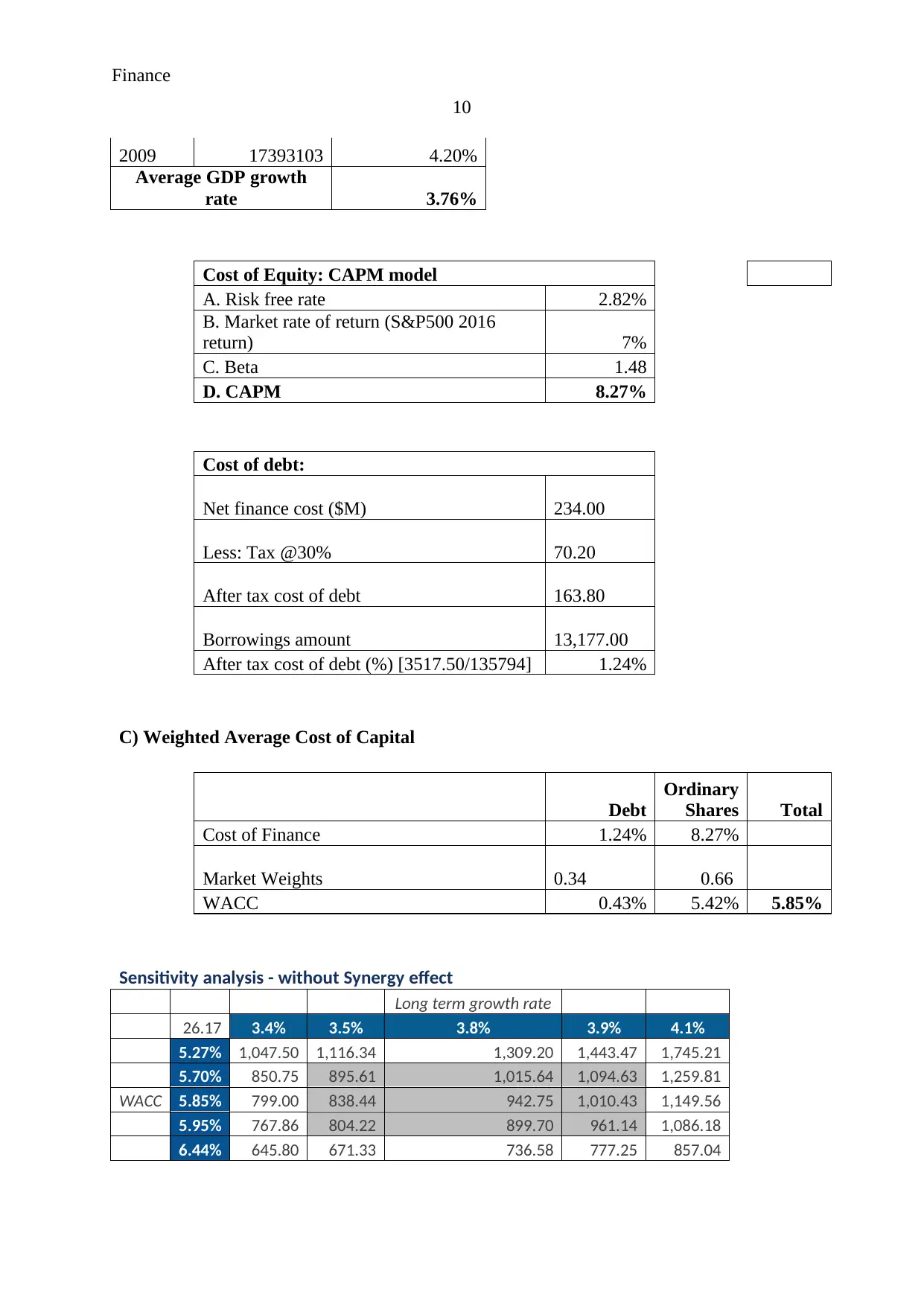
Finance
10
2009 17393103 4.20%
Average GDP growth
rate 3.76%
Cost of Equity: CAPM model
A. Risk free rate 2.82%
B. Market rate of return (S&P500 2016
return) 7%
C. Beta 1.48
D. CAPM 8.27%
Cost of debt:
Net finance cost ($M) 234.00
Less: Tax @30% 70.20
After tax cost of debt 163.80
Borrowings amount 13,177.00
After tax cost of debt (%) [3517.50/135794] 1.24%
C) Weighted Average Cost of Capital
Debt
Ordinary
Shares Total
Cost of Finance 1.24% 8.27%
Market Weights 0.34 0.66
WACC 0.43% 5.42% 5.85%
Sensitivity analysis - without Synergy effect
Long term growth rate
26.17 3.4% 3.5% 3.8% 3.9% 4.1%
5.27% 1,047.50 1,116.34 1,309.20 1,443.47 1,745.21
5.70% 850.75 895.61 1,015.64 1,094.63 1,259.81
WACC 5.85% 799.00 838.44 942.75 1,010.43 1,149.56
5.95% 767.86 804.22 899.70 961.14 1,086.18
6.44% 645.80 671.33 736.58 777.25 857.04
10
2009 17393103 4.20%
Average GDP growth
rate 3.76%
Cost of Equity: CAPM model
A. Risk free rate 2.82%
B. Market rate of return (S&P500 2016
return) 7%
C. Beta 1.48
D. CAPM 8.27%
Cost of debt:
Net finance cost ($M) 234.00
Less: Tax @30% 70.20
After tax cost of debt 163.80
Borrowings amount 13,177.00
After tax cost of debt (%) [3517.50/135794] 1.24%
C) Weighted Average Cost of Capital
Debt
Ordinary
Shares Total
Cost of Finance 1.24% 8.27%
Market Weights 0.34 0.66
WACC 0.43% 5.42% 5.85%
Sensitivity analysis - without Synergy effect
Long term growth rate
26.17 3.4% 3.5% 3.8% 3.9% 4.1%
5.27% 1,047.50 1,116.34 1,309.20 1,443.47 1,745.21
5.70% 850.75 895.61 1,015.64 1,094.63 1,259.81
WACC 5.85% 799.00 838.44 942.75 1,010.43 1,149.56
5.95% 767.86 804.22 899.70 961.14 1,086.18
6.44% 645.80 671.33 736.58 777.25 857.04
Paraphrase This Document
Need a fresh take? Get an instant paraphrase of this document with our AI Paraphraser

Finance
11
11
1 out of 11
Related Documents
Your All-in-One AI-Powered Toolkit for Academic Success.
+13062052269
info@desklib.com
Available 24*7 on WhatsApp / Email
![[object Object]](/_next/static/media/star-bottom.7253800d.svg)
Unlock your academic potential
© 2024 | Zucol Services PVT LTD | All rights reserved.





